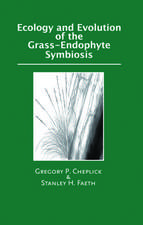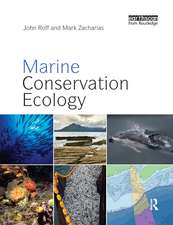Microbial Degradation of Xenobiotics: Environmental Science and Engineering
Editat de Shree Nath Singhen Limba Engleză Paperback – 28 noi 2013
| Toate formatele și edițiile | Preț | Express |
|---|---|---|
| Paperback (1) | 954.14 lei 6-8 săpt. | |
| Springer Berlin, Heidelberg – 28 noi 2013 | 954.14 lei 6-8 săpt. | |
| Hardback (1) | 960.30 lei 6-8 săpt. | |
| Springer Berlin, Heidelberg – 8 oct 2011 | 960.30 lei 6-8 săpt. |
Din seria Environmental Science and Engineering
- 18%
 Preț: 1238.42 lei
Preț: 1238.42 lei - 18%
 Preț: 2166.68 lei
Preț: 2166.68 lei - 18%
 Preț: 1420.88 lei
Preț: 1420.88 lei - 18%
 Preț: 914.20 lei
Preț: 914.20 lei - 18%
 Preț: 1225.94 lei
Preț: 1225.94 lei - 18%
 Preț: 1118.13 lei
Preț: 1118.13 lei - 18%
 Preț: 1402.74 lei
Preț: 1402.74 lei - 18%
 Preț: 3419.93 lei
Preț: 3419.93 lei - 18%
 Preț: 1223.55 lei
Preț: 1223.55 lei - 18%
 Preț: 1008.91 lei
Preț: 1008.91 lei - 18%
 Preț: 1234.46 lei
Preț: 1234.46 lei - 18%
 Preț: 1409.82 lei
Preț: 1409.82 lei - 18%
 Preț: 736.64 lei
Preț: 736.64 lei - 18%
 Preț: 949.73 lei
Preț: 949.73 lei - 18%
 Preț: 1287.47 lei
Preț: 1287.47 lei - 18%
 Preț: 2116.64 lei
Preț: 2116.64 lei - 18%
 Preț: 1231.95 lei
Preț: 1231.95 lei - 15%
 Preț: 641.71 lei
Preț: 641.71 lei - 23%
 Preț: 1129.32 lei
Preț: 1129.32 lei - 18%
 Preț: 1237.93 lei
Preț: 1237.93 lei - 18%
 Preț: 956.18 lei
Preț: 956.18 lei - 24%
 Preț: 1057.94 lei
Preț: 1057.94 lei - 24%
 Preț: 1079.09 lei
Preț: 1079.09 lei - 18%
 Preț: 953.03 lei
Preț: 953.03 lei - 18%
 Preț: 1233.06 lei
Preț: 1233.06 lei - 15%
 Preț: 666.73 lei
Preț: 666.73 lei - 18%
 Preț: 1222.31 lei
Preț: 1222.31 lei - 18%
 Preț: 1242.35 lei
Preț: 1242.35 lei - 18%
 Preț: 1232.89 lei
Preț: 1232.89 lei - 18%
 Preț: 1823.56 lei
Preț: 1823.56 lei - 18%
 Preț: 1228.96 lei
Preț: 1228.96 lei - 18%
 Preț: 1221.69 lei
Preț: 1221.69 lei - 18%
 Preț: 945.79 lei
Preț: 945.79 lei - 18%
 Preț: 1008.28 lei
Preț: 1008.28 lei - 24%
 Preț: 795.50 lei
Preț: 795.50 lei - 18%
 Preț: 1246.47 lei
Preț: 1246.47 lei - 18%
 Preț: 1239.85 lei
Preț: 1239.85 lei - 18%
 Preț: 957.62 lei
Preț: 957.62 lei - 18%
 Preț: 1244.89 lei
Preț: 1244.89 lei - 15%
 Preț: 640.55 lei
Preț: 640.55 lei - 18%
 Preț: 950.33 lei
Preț: 950.33 lei - 18%
 Preț: 1824.01 lei
Preț: 1824.01 lei - 15%
 Preț: 639.59 lei
Preț: 639.59 lei - 18%
 Preț: 947.50 lei
Preț: 947.50 lei - 18%
 Preț: 951.29 lei
Preț: 951.29 lei - 18%
 Preț: 1229.73 lei
Preț: 1229.73 lei
Preț: 954.14 lei
Preț vechi: 1163.58 lei
-18% Nou
Puncte Express: 1431
Preț estimativ în valută:
182.60€ • 198.27$ • 153.38£
182.60€ • 198.27$ • 153.38£
Carte tipărită la comandă
Livrare economică 23 aprilie-07 mai
Preluare comenzi: 021 569.72.76
Specificații
ISBN-13: 9783642269837
ISBN-10: 3642269834
Pagini: 500
Ilustrații: XIV, 486 p.
Dimensiuni: 155 x 235 x 26 mm
Greutate: 0.69 kg
Ediția:2012
Editura: Springer Berlin, Heidelberg
Colecția Springer
Seria Environmental Science and Engineering
Locul publicării:Berlin, Heidelberg, Germany
ISBN-10: 3642269834
Pagini: 500
Ilustrații: XIV, 486 p.
Dimensiuni: 155 x 235 x 26 mm
Greutate: 0.69 kg
Ediția:2012
Editura: Springer Berlin, Heidelberg
Colecția Springer
Seria Environmental Science and Engineering
Locul publicării:Berlin, Heidelberg, Germany
Public țintă
ResearchCuprins
Biodegradation of Aromatic Pollutants by Ligninolytic Fungal Strains.- Microbial Degradation of Polychlorophenols.- Biodegradation of the Explosives TNT, RDX and HMX.- Biodegradation of Military Explosives Rdx and Hmx.
Recenzii
From the reviews:
“The book has the merit to compile the latest knowledge on microbial degradation covering a large range of pollutants that are not usually presented together. It is thus one of the rare books that provide a large image of the microbial metabolism potential for xenobiotic degradation. … the book is of great interest, useful, and would be core reading for researchers and students exploring the microbial degradation capacities.” (Robert Duran, Environmental Science and Pollution Research, Vol. 39, 2012)
“The book has the merit to compile the latest knowledge on microbial degradation covering a large range of pollutants that are not usually presented together. It is thus one of the rare books that provide a large image of the microbial metabolism potential for xenobiotic degradation. … the book is of great interest, useful, and would be core reading for researchers and students exploring the microbial degradation capacities.” (Robert Duran, Environmental Science and Pollution Research, Vol. 39, 2012)
Textul de pe ultima copertă
Our interest in the microbial biodegradation of xenobiotics has increased many folds in recent years to find out sustainable ways for environmental cleanup. Bioremediation and biotransformation processes harness the naturally occurring ability of microbes to degrade, transform or accumulate a wide range of organic pollutants. Major methodological breakthroughs in recent years through detailed genomic, metagenomic, proteomic, bioinformatic and other high-throughput analyses of environmentally relevant microorganisms have provided us unprecedented insights into key biodegradative pathways and the ability of organisms to adapt to changing environmental conditions. The degradation of a wide spectrum of organic pollutants and wastes discharged into the environment by anthropogenic activities is an emerging need today to promote sustainable development of our society with low environmental impact. Microbial processes play a major role in the removal of recalcitrant compounds taking advantage of the astonishing catabolic versatility of microorganisms to degrade or transform such compounds. New breakthroughs in sequencing, genomics, proteomics, bioinformatics and imaging are generating vital information which opens a new era providing new insights of metabolic and regulatory networks, as well as clues to the evolution of degradation pathways and to the molecular adaptation strategies to changing environmental conditions. Functional genomic and metagenomic approaches are increasing our understanding of the relative importance of different pathways and regulatory networks to carbon flux in particular environments and for particular compounds. New approaches will certainly accelerate the development of bioremediation technologies and biotransformation processes in coming years for natural attenuation of contaminated environments
Caracteristici
Provides the state-of-the-art information on bioremediation of a wide range of xenobiotic compounds Serves as a ready reckoner for scientists and environmentalists to solve the problems of persistent organic compounds (POPs) in the ecosystem Presents the microbial degradation as an eco-friendly method of removing pollutants from the environment Includes supplementary material: sn.pub/extras















